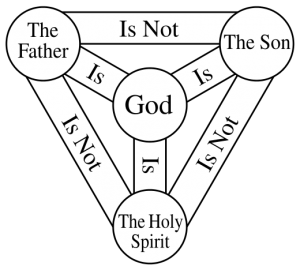One of the strangest doctrines in all of Christianity is the doctrine of the Trinity. This doctrine holds that there are three divine persons — the Father, the Son, and the Holy Ghost — yet only one deity. Each of the three persons is fully God, and not just a part of God. A famous diagram known as the “Shield of the Trinity” compactly summarizes the idea:
The Trinity doesn’t make much sense, and many Christians recognize this. What most of us would call absurd they call a mystery, meaning something that is known to be true through revelation but cannot be demonstrated by mere human reason.
Some questions for the Christians out there:
1. Do you accept the doctrine of the Trinity?
2. Do you recognize the absurdity of it?
3. Do you deal with the absurdity by declaring it a “mystery”?


Fair enough. So how would you define, ‘what actually is’ apart from reality?
Yes, but we don’t see any calendars hung in office walls expressed in metres travelled. ‘We better start shopping it’s only 25 million metres ’till Christmas’ 🙂
If you draw a circle and then draw a closed figure within that circle, does this suddenly prevent the radii from reaching the circumference? We are not dealing with solid objects, we are dealing with mental images of geometrical figures and their transformations. At least that is what I am doing and I presumed you were doing likewise.
That is true (unless we are talking about a straight line and then it is infinite).
When we draw a circle the circumference is a line in space. This line can be thought of as a single curved line. Alternatively, a line can be thought of as being formed by an infinite number of points. It can also be thought of as composed of an infinite number of tangential lines.
Three aspects of the line. A unity between two infinities making up a trinity. Unity in multiplicity.
Shrink the radii down far enough and it reaches the infinitely small point. Expand the circumferential line far enough and it becomes an infinitely long straight line.
Heartbeats may not be weighable but they can be measured.
That is not how I would put it. I would say that thinking is spirit.
I haven’t looked into it enough to know about other cultures in this respect.
Maybe my use of this word is something I’ve unconsciously picked up from reading Steiner and other anthroposophists/Steinerites, I don’t know.
I would say that both these features (mouth and genitals) are expressions of each other and also of a higher unity. In a similar way to the way arms and legs are different ways in which the pentadactyl limb is used. It is expressed mainly as a means of locomotion in our legs, but our upper limbs are capably of so much more and so higher functions are expressed.
It’s a bit like Goethe’s statement on plants that ‘all is leaf’. The leaf and other plant organs are individualised expressions of a higher unity. I hope this helps to clarify what I meant.
Charlie M,
I would define it in terms of the tests that qualify an item for inclusion in it. For example, a scientific test might return a positive result, causing us to add a new particle to our conception of ‘what actually is’.
What is the point you’re trying to make, Charlie?
I am just trying to understand your position regarding the relationship between the world of fundamental physics and the everyday world of our experience.
I don’t want to get caught up in arguments about the meanings of words. Here is Arthur Young:
I haven’t read the book that this excerpt is taken from but I think I might get it. It might even stimulate me to start a new thread. (Although I am open to persuasion, I could be bribed not to 🙂 )
Your thread has prompted me to think more about the relationship between unity and multiplicity and in polarities and about the geometry of form.
Happy Easter everybody.
Charlie,
I’d say that fundamental physics underlies our sensory experiences, and that our knowledge of the former is derived from the latter and from previously acquired knowledge.
Charlie,
This has all been a money-making scheme?? 🙂
Thanks for your answer.
My thinking is that we cannot get around the fact that we imagine fundamental ‘particles’ in terms of the everyday objects and processes around us. There is a strong tendency to endow them with attributes applicable to the world of our senses.
Language is made up of letters and words but the creativity does not lie in these basic units. They are the means by which the creativity is expressed. Atoms and molecules have the same relationship to life. The creativity belongs at a higher level.
I’d give you an address to send the cheques but then you’ll know where I live, so I’ll settle for paypal 🙂